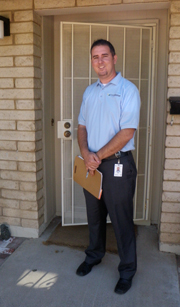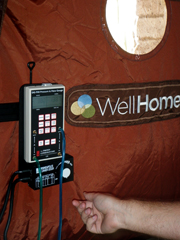I met Jerry Ufnal while volunteering for the Greenbuild conference last year. He was the chair of the media and public relations committee for the local effort behind the national conference. Jerry is a leader in the green building community and is a wealth of information when it comes to energy efficiency. He was kind enough to write a guest post about his experience with a new trend in the green building industry, Home Energy Assessments:
____________________________________________________________________________
 Mornings are still pleasant in Phoenix, so I leave the door open in my office for fresh air as I wait for home performance advisor Mike Hifler to arrive. Mike is dropping by with an assessment of my home based on thorough inspection he did about 10 days ago.
Mornings are still pleasant in Phoenix, so I leave the door open in my office for fresh air as I wait for home performance advisor Mike Hifler to arrive. Mike is dropping by with an assessment of my home based on thorough inspection he did about 10 days ago.
He starts with flattery. “You‘re more energy conscious than a lot of consumers, so you are already doing a lot of things right,” he tells me. I’ve helped market energy efficiency programs for utilities for about two decades, so I do have the behavior side of energy management under modest control. But in the last few years, I’ve been remodeling my 1970-era home and I thought it was time to reduce my carbon footprint with some improvements to my energy infrastructure.
So I invited WellHome to conduct a thorough home energy assessment. WellHome is one of many companies that now provide this service using some advanced diagnostic equipment that I was familiar with but had never put to good use firsthand. Now was the time.
On his first visit, Mike inspected the house and took notes on the efficiency of my appliances and some usage information. He inspected the exterior of the building looking for trouble spots where the heat of summer might penetrate the house. He checked on my pool pump and motor.
Then he broke out the high tech gear and my attention shot up. Mike affixed a blower door to my entrance and pressurized the home for a baseline reading to see how much leakage occurs. A blower door consists of a fan, a digital measuring device, and a cover that is fit to your front door. I was momentarily anxious wondering if I would feel the effects while inside, like on those old Memorex ads where a guy is windswept by the music gushing from his speakers. This didn’t happen, but my interior door to the garage kept popping open because my latch was loose. I held it shut for the duration of the test.
A blower door test being performed
Mike then sealed the ductwork and took a second reading to detect how much air was escaping through my ductwork. When they built homes like mine that are over forty years old, they did not seal the ducts in the same way that is recommended today. In fact, some were barely sealed at all. They just jammed two ends of sheet metal ductwork together to do the job. As a result, lots of cooling can squeeze out from poor connections, in essence, cooling your attic space. The test results showed this was the case for my home and I would need to seal the ducts to end the waste.
Vents are temporarily sealed to evaluate duct leakage
We also used a thermal imaging camera to see hotspots where outdoor heat was affecting my indoor climate. At nearly every lighting fixture or fan hanging from the ceiling, I could see a hot spot with the camera. This is a common finding that can easily be remedied with a can of spray foam insulation from my local home improvement store. I had some up-ducts from an old whole house system that went with an evaporative cooler that was removed years ago. Even though I had filled them with polystyrene, they were blazing in the thermal camera image and should probably be removed and sealed.
These antiquated up-ducts are a source of air infiltration
These results were all outlined in the extensive energy assessment report that Mike brought with him this morning. It broke out my energy use by different categories based on an average home. About 41% of the energy was going to cool the house, about 26% for heat and water heating, and another 24% to run appliances. Of the energy used for cooling and heating the house, about 19% could be lost to infiltration and another 36% to windows.
A home assessment chocked full of good energy information
From the blower door test, I could see that my infiltration was a bit above average. Just to accent that point, my home assessment report included the thermal images of all the hot spots where cooling could be escaping. The report recommended that I add insulation to my attic space. My insulation was providing an average of R15 of insulating value in my ceiling and Mike was recommending beefing that up to at least an R39. His proposal included estimated costs and the anticipated energy savings so I could clearly see what the payback would be on my investment. Additionally, he recommended sealing the duct work using mastic and a radiant barrier to seal and cover the ductwork in my plenum.
These were all solid recommendations and exactly what I wanted from a home performance assessment. I have a roadmap to energy savings and an estimate of the costs involved and the positive impact that can result. There are some measures that I will do myself and others that I will likely engage a contractor to do. The report even indicated how much money would be saved through tax credits and utility incentives.
Normally, a home assessment that included a blower door test, a duct leakage test, and use of the thermal imaging camera would cost as much as $400. But thanks to a new program from APS called the Home Performance with ENERGY STAR© program, the service is just $99, and it comes with some CFLs and a nifty low flow showerhead that stops the flow of water when you get to the right temperature setting. Plus, APS offers special rebates for insulation, duct sealing and shade screens if you get your assessment through the program.
If you are committed to reducing your carbon footprint or just want to trim back on the amount of energy you use around the house, I think this service is a great way to get started on the road to greater efficiency.
Jerry Ufnal is a marketing professional with nearly twenty-five years worth of experience promoting energy efficiency. He is currently a market liaison for the APS Solutions for Business program, calling on commercial, governmental and institutional building owners, architects, builders, and engineers to improve energy performance and earn incentives from APS.
Photo Credits: Initial photo is of Mike Hifler, with WellHome. All photos by Jerry Ufnal





















